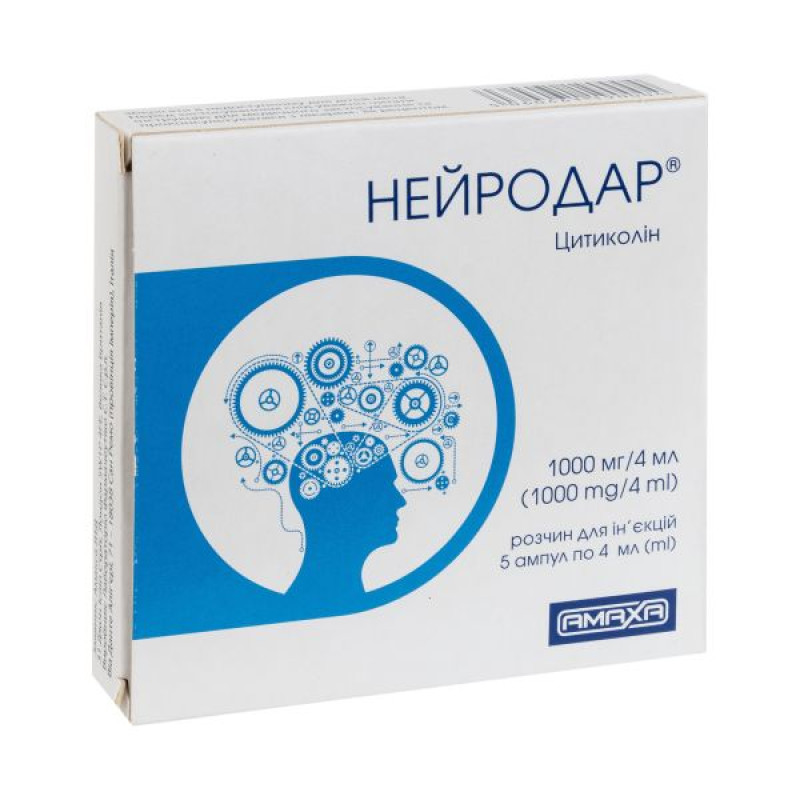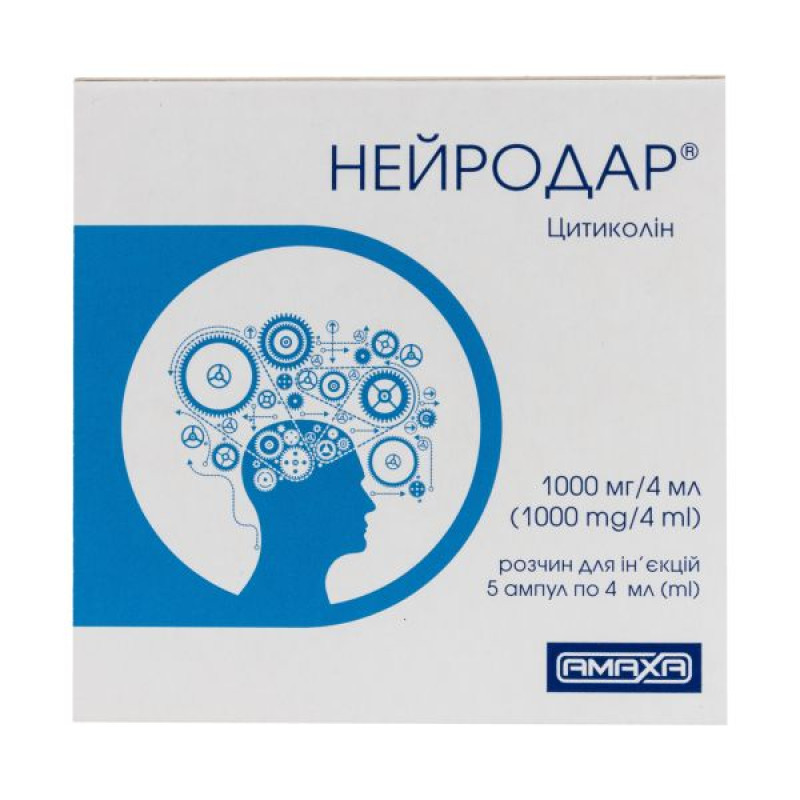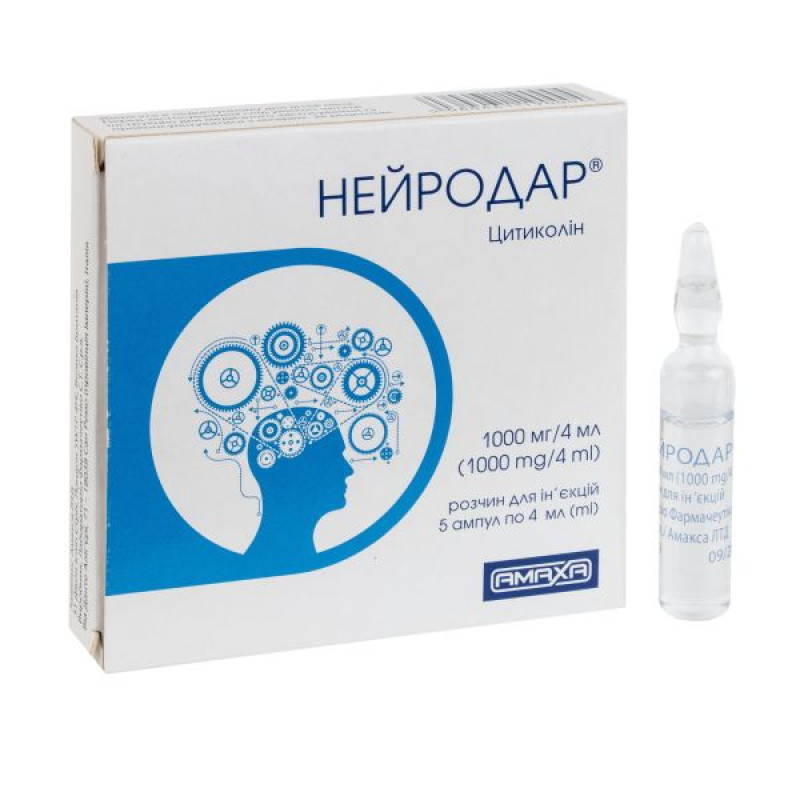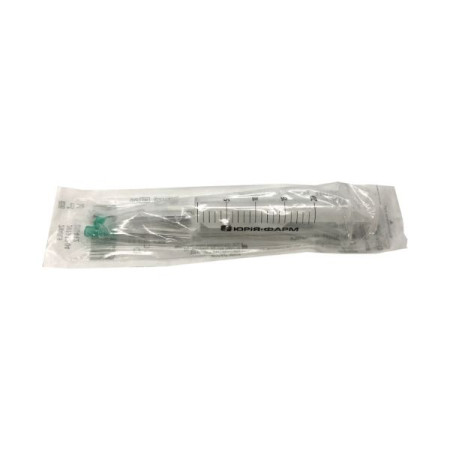Neurodar solution for injection 1000 mg/4 ml ampoule No. 5

Instructions Neurodar solution for injection 1000 mg/4 ml ampoule No. 5
Composition
active ingredient: citicoline;
1 ampoule (4 ml) contains citicoline sodium equivalent to citicoline 500 mg or 1000 mg;
excipient: water for injections.
Dosage form
Solution for injection.
Main physicochemical properties: transparent colorless solution.
Pharmacotherapeutic group
Psychostimulants and nootropics. ATX code N06B X06.
Pharmacological properties
Pharmacodynamics
Citicoline stimulates the biosynthesis of structural phospholipids in the membrane of neurons, which contributes to the improvement of membrane function, including the functioning of ion exchange pumps and neuroreceptors. Due to its stabilizing effect on the membrane, citicoline exhibits anti-edematous properties, therefore reducing brain edema. Research results have shown that citicoline inhibits the activity of some phospholipases, prevents the residual formation of free radicals, prevents damage to membrane systems and ensures the preservation of the protective antioxidant system.
Citicoline reduces the volume of damaged tissue, prevents cell death by acting on apoptosis mechanisms, and improves cholinergic transmission. Citicoline also has a preventive neuroprotective effect in focal brain strokes.
Citicoline promotes rapid functional rehabilitation of patients with acute cerebral circulation disorders, reducing ischemic damage to brain tissue, which is confirmed by the results of X-ray studies.
In case of traumatic brain injuries, citicoline shortens the duration of the recovery period and reduces the intensity of post-traumatic syndrome.
Citicoline helps increase the level of brain activity, reduces the level of amnesia, and improves the condition of cognitive, sensory, and motor disorders observed in cerebral ischemia.
Pharmacokinetics
Citicoline is well absorbed after oral, intramuscular and intravenous administration. After administration of the drug, a significant increase in the level of choline in the blood plasma is observed. When administered orally, the drug is almost completely absorbed. Studies have shown that the bioavailability after oral and parenteral administration is almost the same.
The drug is metabolized in the intestines and liver to form choline and cytidine. After administration, citicoline is absorbed by brain tissues, with cholines acting on phospholipids, cytidine on cytidine nucleoids and nucleic acids. Citicoline quickly reaches brain tissues and is actively incorporated into cell membranes, cytoplasm and mitochondria, activating the activity of phospholipids.
Only a small amount of the administered dose is excreted in the urine and feces (less than 3%). Approximately 12% of the administered dose is excreted through the respiratory tract. The excretion of the drug with urine and through the respiratory tract has two phases: the first phase is rapid excretion (with urine - during the first 36 hours, through the respiratory tract - during the first 15 hours), the second phase is slow excretion. The main part of the drug dose is involved in metabolic processes.
Indication
– Acute phase of cerebrovascular disorders, complications and consequences of cerebrovascular disorders.
– Traumatic brain injury and its consequences.
– Neurological disorders (cognitive, sensitive, motor) caused by cerebral pathology of degenerative and vascular origin.
Contraindication
Hypersensitivity to the components of the drug, increased tone of the parasympathetic nervous system.
Interaction with other medicinal products and other types of interactions
Citicoline enhances the effect of levodopa. The drug should not be prescribed simultaneously with drugs containing meclofenoxate.
Application features
In case of persistent intracranial hemorrhage, the dose should not exceed 1000 mg per day and the intravenous infusion rate should not exceed 30 drops per minute.
The drug is used immediately after opening the ampoule. The ampoule with the drug is intended for single use only. Any remaining drug should be destroyed.
Use during pregnancy or breastfeeding
There are no sufficient data on the use of citicoline in pregnant women. There is no data on the excretion of citicoline into breast milk and its effects on the fetus. Therefore, during pregnancy or breastfeeding, the drug is prescribed only if the expected benefit to the mother outweighs the potential risk to the fetus.
Ability to influence reaction speed when driving vehicles or other mechanisms
In some cases, some adverse reactions from the central nervous system may affect the ability to drive or operate complex machinery.
Method of administration and doses
For intravenous or intramuscular administration.
The recommended dose for adults is 500 mg to 2000 mg per day.
Treatment in the first 2 weeks is prescribed at 500-1000 mg 2 times a day intravenously, then at 500-1000 mg 2 times a day intramuscularly.
The maximum daily dose is 2000 mg.
If necessary, treatment is continued with oral citicoline. The recommended course of treatment, at which the maximum therapeutic effect is observed, is 12 weeks.
The dosage of the drug and the duration of treatment depend on the severity of the brain lesions and are determined by the doctor individually.
Intravenously administered in the form of a slow intravenous injection (over 3-5 minutes depending on the dose administered) or intravenous drip infusion (40-60 drops per minute).
Elderly patients do not require dose adjustment.
Children. There is insufficient data on the use of the drug in children. The drug is used in case of urgent need, when the expected benefit from use outweighs the possible risk.
Overdose
Cases of overdose have not been described.
Adverse reactions
Adverse reactions occur very rarely (< 1/10,000), including isolated cases.
Mental disorders: hallucinations.
From the nervous system: severe headache, dizziness.
From the cardiovascular system: arterial hypertension, arterial hypotension, tachycardia.
Respiratory system: dyspnea.
From the digestive tract: nausea, vomiting, diarrhea.
General disorders: chills, edema, allergic reactions, including rash, purpura, itching, angioedema, anaphylactic shock, fever, increased sweating, injection site reactions.
Expiration date
3 years.
Storage conditions
Store at a temperature not exceeding 25 °C in the original packaging.
Keep out of reach of children.
Incompatibility
The drug should not be mixed with other medicines in the same container.
Packaging
500 mg/4 ml: 4 ml of the drug in an ampoule, 5 ampoules in a contour blister pack, 1 pack in a cardboard box.
1000 mg/4 ml: 4 ml of the drug in an ampoule, 5 ampoules in a contour blister pack, 1 pack in a cardboard box.
Vacation category
According to the recipe.
Producer
Laboratorio Pharmaceutico S.T. S.r.l.
Laboratorio Farmaceutico CTSrl
Location of the manufacturer and its business address
Via Dante Alighieri, 71 – 18038 San Remo (Province of Imperia), Italy
Via Dante Alighieri, 71 - 18038 San Remo (IM), Italy
Applicant
Amaxa Pharma LTD
Amaxa Pharma LTD
Applicant's location
9 Wimpole Street, W1G 9SG London, United Kingdom
9 Wimpole Street, W1G 9SG London, United Kingdom
There are no reviews for this product.
There are no reviews for this product, be the first to leave your review.
No questions about this product, be the first and ask your question.










